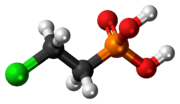Ethephon
 | |
 | |
| Names | |
|---|---|
| IUPAC name
2-Chloroethylphosphonic acid | |
| Other names
Bromeflor Arvest Ethrel | |
| Identifiers | |
3D model (JSmol) |
|
| ChEBI | |
| ChemSpider | |
| ECHA InfoCard | 100.037.002 |
| KEGG | |
PubChem CID |
|
| UNII | |
CompTox Dashboard (EPA) |
|
| |
| |
| Properties | |
| C2H6ClO3P | |
| Molar mass | 144.49 g·mol−1 |
| Density | 1.409 g/cm3 |
| Melting point | 74 °C (165 °F; 347 K) |
| 123.9 g/100 mL (23 °C) | |
| Hazards | |
| Main hazards | Corrosive |
Except where otherwise noted, data are given for materials in their standard state (at 25 °C [77 °F], 100 kPa). | |
| Infobox references | |
Ethephon is a plant growth regulator.[1]
Mechanism of action
Upon metabolism by the plant, it is converted into ethylene, a potent regulator of plant growth and ripeness. It is also a butyrylcholinesterase inhibitor.[2]
Uses in various crops
Ethephon often used on wheat, coffee, tobacco, cotton, and rice in order to help the plant's fruit reach ripeness more quickly.
Cotton is the most important single crop use for ethephon. It initiates fruiting over a period of several weeks, promotes early concentrated boll opening, and enhances defoliation to facilitate and improve efficiency of scheduled harvesting. Harvested cotton quality is improved.[3][4]
Ethephon also is widely used by pineapple growers to initiate reproductive development (force) of pineapple. Ethephon is also sprayed on mature-green pineapple fruits to degreen them to meet produce marketing requirements. There can be some detrimental effect on fruit quality.
The toxicity of ethephon is very low,[5] and any ethephon used on the plant is converted very quickly to ethylene.[6]
The use of this chemical is allowed in the European Union.
References
- "R.E.D. Facts Ethephon" (PDF). Environmental Protection Agency.
- Zhang, Nanjing; Casida, John E (2002). "Novel Irreversible Butyrylcholinesterase Inhibitors: 2-Chloro-1-(substituted-phenyl)ethylphosphonic Acids". Bioorganic & Medicinal Chemistry. 10 (5): 1281. doi:10.1016/s0968-0896(01)00391-1.
- Christopher L. Main and Robert M. Hayes. "Cotton Harvest Aids" (PDF). University of Tennessee Institute of Agriculture.
- Bill L. Weir and J. M. Gaggero (1982). "Ethephon may hasten cotton boll opening, increase yield". California Agriculture.
- Pesticide Information Profiles: Ethephon, Extension Toxicology Net. Sept 1995.
- "1994 Joint meeting of the FAO panel of experts on pesticide residues in food and the environment." UN Food and Agriculture Organization. 1994.